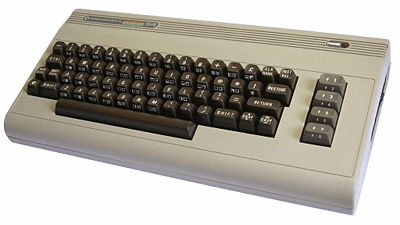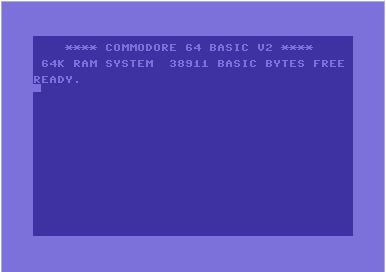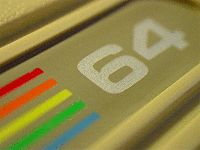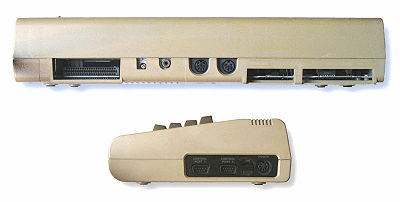C64
| C64 | |
| Type: | Home Computer |
| Producer: | Commodore |
| Price: | under 600 US$ |
| Released: | 1982 |
| Discontinued: | 1993 |
| Processor: | MOS 6510/8500 @ ca. 1 MHz |
| Memory: | 64 KByte, upgradeable |
| OS: | BASIC V2.0 |
| Info: | - alias C-64, VIC-64; VIC-64S; VC-64 and CBM-64 - Nicks: 64er or CeVi, classical models bread box - differents designs - Forerunner: VIC-20 - Follower: C128/D/DCR |
This article can only show you a small overview about the potential of the home computer Commodore 64. More details and other tricks and hints have their own article in this wiki.
The Commodore 64 (short: C64; alternative CBM64, C=64, VIC-64, in Germany VC-64, in Sweden VIC=64S) is the most favored and best-selling home computer of the 80's, which was built from 1982 until 1993. The C64 is the successor of the first colour video home computer VIC20. The successor of the C64 is the C128, which was sold as an office-computer. The C64 was voted the computer of the year twice in the category home computer by an international committee of journalists from computer magazines.
The statements of the sales figures are very different. The declaration of 30 million sold C64s is way too high. The realistic statement is something about 17 million and in Germany, Commodore has sold about 3 million C64s. The fall of the Berlin wall, in 1989, was a lucky chance for the C64. The C64 was sold in eastern Europe until the collapse of Commodore due to financial trouble.
Contents[hide] |
[edit] Characteristics
The advantage of the C64 is, that the technology concept uses the whole 8-bit-memory-map (64 KByte). It contains several sound and graphic features (like sprites, HiRes, multicolor). The existing VIC-20-peripherals can be used after a little remodeling, and easy Commodore-BASIC-programs until version 2.0 can be used. The C64 can be operated with CP/M, when a Z80 CPU Cartridge (very rare!) is used. There are other program cartridges for programming languages like Logo or Pascal.
Especially in Germany, the computer market reacted very fast in favour of the C64. Several C64 related books and magazines were available soon after the release. The German publishers Markt & Technik, Data Becker or Heise Verlag used their experience from the VIC-20, PET and PC-CBM for the new C64. The most popular C64 magazine in Germany was the 64'er, but these other international home computer magazines might be interesting, too:
- Ahoy! (USA)
- Commodore Computing International (England)
- Commodore Force (England)
- Commodore Format (England)
- Commodore Horizons (England)
- commodore power/play (USA, Commodore magazine for computer players by Commodore)
- Commodore World (USA)
- Compute! (USA)
- Compute!'s Gazette (USA)
- Creative Computing (USA)
- Loadstar disk mag (USA, England)
- Retro Gamer (British and German publishers and editons)
- RUN (USA and German Publishers and editons)
- The Transactor, later Commodore INTERFACE, later commodore - the microcomputer magazine, later Commodore Magazine (Kanada, USA, Commodore house magazine started by Commodore)
- VIC-rapport (Sweden)
- Your Computer (Australian and british Publishers and editons)
- Your Commodore (England)
- Zzap!64 (game magazine)
These magazines usually contained program-listings which were essential before floppy discs became widely used. Users could get a wide range of interesting software for quite cheap. Other general computer magazines couldn't elude the home computer trend and had program-listings for C64 and other computers, as well: German computer magazines MC, CHIP or C'T.
Software on data storage (disk, cassette or cartridge) was much more expensive. The middle course were specialized diskmags like the German disk mags INPUT 64, Magic Disk 64, Game On or Golden Disk 64, which contained software on a tape or disc and articles relating to the included software.
The initial price for the C64 was under US$ 600 (in Germany 1395 DM - today ca. 700 €). In Europe was the price reduction for the C64 after the start huge. At the end of the 1980s was the price for the first C64 models about 400 DM (today ca. 200 €) - also the floppy price for a VIC-1541 (round about 500 DM; today ca. 250 €).[1][2]
[edit] Construction
C64 - Motherboard 1982.
C64 - Motherboard 1992.
Several variants of the C64 were built. The prototype of the C64 had the same case as its predecessor the VIC20, which looks like a brown bread box, with black keys and brighter function-keys. The first production run differs in case and keyboard colors. Commodore used several different parts from other computers. This procedure was very common at Commodore, therefore there are several different versions of the same model, even with later models. The following models and variants were brighter, modern designed or more flat, but the concept as a keyboard-computer (exception: SX-64 and C64 Game System) was essentially the same. The ports and interfaces are (i - input / o - output for datas):
[edit] Side Panel
- Two gameports (Controlports, 9-pins, i) to connect a joystick, lightpen, mouse or a few paddles
- Power Switch
- Power Connector (Power; 7-pins) to connect for the power supply (4-pins)
[edit] Rear
- Expansion port (44-pins; i/o) to connect cartridges
- TV-connector (HF-Modulator-Output; o) to connect a television (in the versions NTSC or PAL)
- Audio-/Video (5-pins; o) to connect a monitor or a stereo
- Serial Bus (IEEE-488, 6-pins, i/o) to connect a diskdrive VIC-1541/70/71/81 or printer MPS-801/802/803, VIC-1515/1525/1526
- Cassette Connector (Cassette port 12-pins; i/o) to connect a cassette recorder (Datasette) VIC-1530 or CN2
- Userport (RS-232 or Centroncis; 24-pins; i/o) to connect cartridges, reset button or modems.
[edit] Mainboard
- CPU: MOS 6510 or 8500 ~ 1 MHz
- Memory: 64 KByte RAM, with 38911 bytes free usable under BASIC
- ROM: 20 KByte, divided into:
- Graphic: VIC-II
- NTSC-version: 6566/6567/8562
- PAL-version: 6569/8565
- Screen modes: Text mode (big/graphic letters or big/small letters) 40 (rows) * 25 (columns) chars or in graphic mode (HiRes) 320*200 pixel in 16 colours, 16 border-colour and 16 background-colour (colour) or multicolor (4 colours) 160*200 pixel, 8 sprites (HiRes or multicolor) in BASIC
- Sound: SID 6581/8580 are used for sound generation with 3 independent voices over 8 octaves (~96 notes) or noises with filter.
- Keyboard: 66 keys (QWERTY), with multiple chars
- Others: 2 interface-chips CIA-6526 for I/O-control
[edit] Technical Details
For the all technicals details see also the article Hardware Assembly of the C64.
CPU : 6510 @ 0.9852486MHz (PAL)
1.0227273MHz (NTSC)
RAM : 64 Kb DRAM
.5 Kb SRAM (colour RAM $d800-dbff)
ROM : 20kB ROM together, in 3 ROMs :
- 8k BASIC V2 ($a000-bfff)
- 8k Kernal ($e000-ffff)
- 4k Character ROM ($d000-dfff)
(In new versions BASIC and Kernal are together in a 16 Kb-ROM)
Graphic : VIC-II ($d000-d3ff)
Sound : SID ($d400-d7ff)
Interfaces : User port
Expansion port
Audio/Video connector
Cassette interface
Game port (2x)
Serial IEC-Port
TV Connector
Keyboard : 66 Keys (included Graphic Letters)
Power Supply : Extern (9V AC, +5V DC)
[edit] Accessories
There is a wide range of devices for the C64:
Input: mouse, joystick, lightpen or paddles
Drives: Commodore-cassette-driver ("Datassette" VIC-1530 / CN2), disk drives (VIC-1541/70/71/81), hard disks
Peripherals: modem, printer, cartridges
Since the bankruptcy of Commodore in 1994, the C64-scene has remained quite active. A lot of projects from the C64-scene are using modern technology with C64s. For example: IDE hard disks and CD/DVD-drives, memory cards, use of MP3-files or the internet.
[edit] Variants
The production period of the C64 was about 10 years. That is the reason, that a lot of keyboard box designs (color: white, brown, etc; shape: bread box or v formation) and C64 based computers (like MAX Machine, PET64, SX-64, C64 GS) was manufactured.
- 1982 in USA, 1983 in Germany: C64-Prototype: grey bread box with black keys (until 1984)
(Silver Label[3]):)- lined with plastic (convex form)
- metallic (e.g.. export and US models)
- paper (very rare, for example units with three digit serial numbers)
- 1982: Commodore MAX Machine (VC-10): Slimming version of the C64 like a game computer (or a video game console) only sold in Japan.
- 1982: PET64: alias the Educator 64 is a special model for schools with integrated monitor than first educational computer.
- 1983: SX-64, also DX64 and SX100: A portable C64 with integrated disk drive and monitor.
- 1984 in USA, 1986 in Germany: Golden C64 series
- A limited edition of the C64 with gold-colored keyboard box. - 1986: C64C or C64-II: Gray colored, flat design, which looks like the C128 (keyboard version).
- 1987: C64-Aldi: A special german version of a low cost C64, which was selling in German famous supermarket called ALDI.
- 1988: C64G: Low cost C64 with newer board and light gray case.
- 1988: C64C CR: Low cost C64C, plastic clips instead of screwed together.
- 1990: C64 Games System (C64 GS): Constricted version (without keyboard and lower interfaces) of C64 like a game console (1990).
[edit] Using
After turning on BASIC 2.0, the C64's operating system can be used directly. It's possible to run programs from data storage devices like disks or tapes, or by writing your own BASIC programs and then saving them on disk or tape, or printing the program listing on a printer.
Several cartridges have the ability to modify the C64. Cartridges have a benefit because there is no loading time like there is with disks or tapes. Some cartridges upgrade the BASIC system and can be helpful for writing programs. Other programming languages are easier to use with cartridges like Pascal or operation systems CP/M.
[edit] Compatible to VIC-20, C64 and C128 or CBMs
The other Commodore computers like VIC20 and C128 also use the BASIC 2.0 (whereas the C128 has a better version implemented, see below). That allows software to be transferred from one device to another using data storage. The biggest problem is, that the memory maps differ from the C64. That means that BASIC programs with BASIC system commands like PEEK, POKE, SYS or USR cannot be used if they have been written for another Commodore Computer. C64-software is almost 100% compatible to a C128, as long as the C128 is operated in the C64-mode.
The VIC-20 has 5kb of memory (3.583 bytes RAM free in BASIC), far less than the C64 with 64kb (38.911 bytes in BASIC), and cannot use sprites, so you can only transfer simple and short BASIC-programs from a C64 to a VIC20. The C128 has about 128kb of memory and the more sophisticated BASIC 7.0. It's therefore possible to transfer a wide range of BASIC programs.
Some BASIC-programs (until BASIC 2.0) from a PET or PC-CBM-series (3000/4000/8000) can be used on a C64. A trick can be used to run C64 programs on a PET/CBM computer. Before the C64-program will be loaded, you need to type and run this command line:
POKE 40,1: POKE 41,8: POKE 8*256,0: NEW
Software with higher BASIC-versions than 2.0 cannot be used on the C64 without software-upgrades or cartridges.
[edit] Links
| Wikipedia: C64 |
- The C64 timeline at pctimeline.info
- Commodore 64 at 8Bit-Museum

- Commodore 64 at CBM-Museum Kuto

- C64 models at C64-Online

- VIC=64S Broschüre

- VIC=64S Zubehörbroschüre

[edit] Videos
- Video at YouTube C64 TV advertise 1982
- Video at YouTube C64 TV advertise 1982
- Video at YouTube C64 TV advertise as learning computer 1982
- Video at YouTube Australian C64 TV advertise 1983
- Video at YouTube C64 TV advertise 1983
- Video at YouTube C64 TV advertise 1985
- Video at YouTube C64 TV advertise 1982
- Video at YouTube C64 TV advertise 1982
- Video at YouTube C64 TV advertise 1985
- Video at YouTube "Commodore C64 - 1982", Introducion with Jim Butterfield (2:07 Std.)






